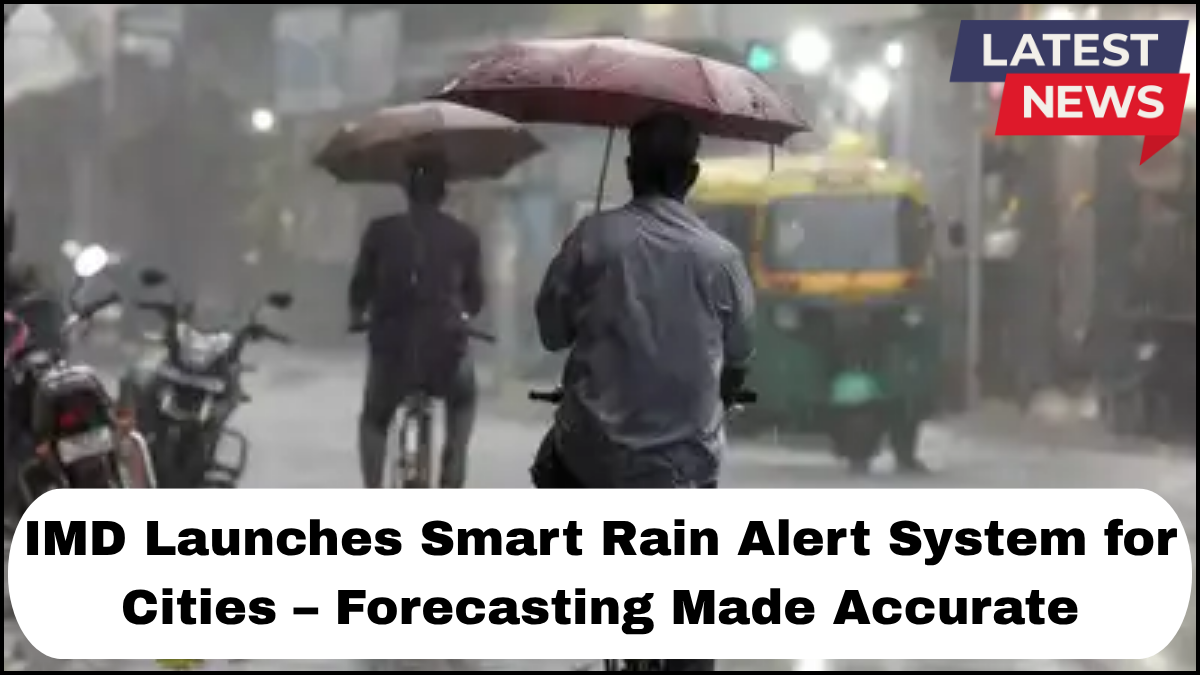The India Meteorological Department (IMD) has taken a major leap in urban weather forecasting by launching its Smart Rain Alert System for Cities. This state-of-the-art initiative aims to transform how rainfall is predicted, monitored, and communicated across urban landscapes. As cities grapple with sudden downpours, urban flooding, and climate unpredictability, this advancement marks a crucial step toward smarter, data-driven urban resilience.

What Is the IMD Rain Alert System?
The IMD Rain Alert System is a cutting-edge weather forecasting solution that integrates real-time meteorological data, satellite imaging, radar inputs, and Weather Forecast AI to generate hyperlocal rainfall alerts. Unlike traditional systems that provide general forecasts for large regions, this new system delivers city-specific warnings that can pinpoint down to individual districts or localities.
Using advanced AI and machine learning algorithms, the system can detect rain cloud movement, intensity build-up, and likely impact areas, offering timely alerts to municipal bodies, emergency services, and citizens.
Why Cities Need Smarter Rain Alerts
Urban environments are particularly vulnerable to sudden, intense rainfall due to high population density, concrete infrastructure, and poor drainage systems. Flash floods in cities like Mumbai, Bengaluru, and Delhi have led to massive disruptions and damage in recent years.
By providing real-time and location-specific data, the IMD Rain Alert System allows:
- Timely evacuation in flood-prone zones
- Early warnings for commuters and public transport
- Targeted deployment of civic resources like water pumps and rescue teams
- Enhanced preparedness for hospitals, schools, and public utilities
This kind of granular forecasting is a game-changer in emergency planning and urban disaster mitigation.
Technology Behind the System
At the heart of the Smart Rain Alert System is an AI-driven analytical engine that processes inputs from:
- Doppler Weather Radars (DWR)
- INSAT-3D and 3DR satellite data
- Ground-level sensors
- Historical weather databases
These data streams feed into deep learning models trained to predict not only rainfall but its severity, duration, and movement. This Weather Forecast AI system continuously updates itself based on new observations, improving accuracy over time.
The alerts are then sent through multiple channels:
- SMS and mobile push notifications
- Public announcements via loudspeakers and digital signboards
- Municipal control rooms
- Integration with smart city dashboards
Implementation Strategy Across India
Initially, the IMD is rolling out the system in 50 major cities, including metros and flood-prone urban centers. The goal is to eventually cover all Tier 1 and Tier 2 cities within two years.
The implementation involves close coordination with:
- Urban Local Bodies (ULBs)
- State Disaster Response Forces (SDRFs)
- National Disaster Management Authority (NDMA)
Workshops and training programs are being held to ensure that civic officials can interpret the alerts correctly and respond effectively.
Positive Impact on Urban Planning
Besides immediate emergency management, the system offers long-term benefits for urban development. With historical and predictive rainfall data, city planners can:
- Identify flood-prone zones for infrastructure upgrades
- Design better stormwater drainage networks
- Implement zoning regulations based on weather risk profiles
This aligns with India’s broader smart city mission, which emphasizes resilience, sustainability, and citizen-centric planning.
Public Engagement and Awareness
The success of the IMD Rain Alert System also depends on public participation. The IMD has launched awareness campaigns to encourage citizens to:
- Subscribe to alerts via the Mausam App or SMS
- Follow advisories issued before and during heavy rains
- Share real-time local updates through crowd-sourced platforms
Final Thoughts
The IMD’s Smart Rain Alert System is not just a technological innovation; it’s a strategic response to the growing challenges of climate change and urban flooding. By combining Weather Forecast AI with real-time data and public communication, the initiative sets a new benchmark in predictive urban weather management.
As more cities get integrated into this network, India stands to become a global model for proactive, AI-enabled disaster readiness.
FAQs
Q1: How can citizens access the IMD Rain Alert System?
Citizens can receive alerts through the Mausam App, SMS services, and local digital signage. Municipal bodies also disseminate warnings via public announcements.
Q2: Which cities currently have access to the Smart Rain Alert System?
The system is being launched in 50 key cities in the first phase, including Mumbai, Delhi, Chennai, Bengaluru, and Kolkata.
Q3: What makes this system more accurate than traditional forecasts?
It uses AI and machine learning to process real-time satellite and radar data, offering hyperlocal predictions instead of broad regional forecasts.
Q4: Can businesses use this system for operational planning?
Yes, industries like logistics, construction, and public transport can integrate these alerts into their planning and risk mitigation strategies.
Q5: Is the system available in regional languages?
Yes, alerts and advisories are being provided in multiple Indian languages to ensure broader accessibility.
click here to learn more